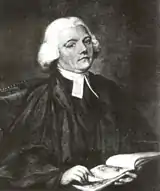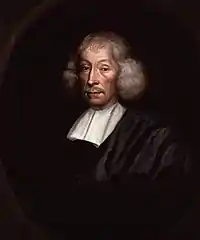Parson-naturalists were ministers of religion who also studied natural history. The archetypical parson-naturalist was a priest in the Church of England in charge of a country parish, who saw the study of science as an extension of his religious work. The philosophy entailed the belief that God, as the Creator of all things, wanted man to understand his Creations and thus to study them through scientific techniques.[1] They often collected and preserved natural artefacts such as leaves, flowers, birds' eggs, birds, insects, and small mammals to classify and study. Some wrote books or kept nature diaries.
Parson-naturalists
| Name | Dates | Description | Known for | Portrait |
|---|---|---|---|---|
| Turner, William[2] | 1508?–1568 | Dean of Wells Cathedral | Herbalism Libellus de Re Herbaria |
 |
| White, Gilbert[3] | 1720–1793 | Curate of Selborne, Hampshire ornithology |
Natural History and Antiquities of Selborne |  Probably not authentic |
| Ray, John[4] | 1627–1705 | Father of English natural history; taxonomy; empiricism |
Historia Plantarum |  |
| Derham, William[5] | 1657–1735 | Physico-Theology, (Natural theology) | Estimated speed of sound Astronomy, listed nebulae |
 |
| Lightfoot, John[6] | 1735–1788 | Botanist Conchologist |
Flora Scotica (1789) |  |
| Henslow, John Stevens[7] | 1796–1861 | Botanist, Geologist | Mentor and friend of his pupil Charles Darwin |  |
| Jenyns, Leonard[8] | 1800–1893 | Priest, founder of Bath Natural History and Antiquarian Field Club |
Phenology and meteorology observations | |
| Fox, William Darwin[9] | 1805–1880 | Priest, Entomologist, collector of beetles | Tutored his second cousin Charles Darwin in natural history | 
|
| Tristram, Henry Baker[10] | 1822–1906 | Biblical scholar, Ornithologist | Early acceptance of Darwinism, tried to reconcile it with creation |
 |
| Wood, John George[11] | 1827–1889 | Natural history populariser and lecturer | Common Objects of the Country |  |
| Dallinger, William[12] | 1839–1909 | Methodist minister, microbiology | Research on monads Opposition to spontaneous generation |
|
| Cowper, Spencer[13] | 1713–1774 | Dean of Durham 1746–1774 | Meteorology |  |
| Morris, Francis Orpen[14] | 1810–1893 | Irascible Irish clergyman Strongly opposed Darwinism & fox-hunting Campaigned for bird conservation law |
History of British Birds A Bible Natural History Records of Animal Sagacity and Character Dogs and Their Doings |

|
| Bloxam, Andrew[15] | 1801–1878 | Naturalist on HMS Blonde Later priest and naturalist |
Recorded and collected Hawaiian birds, some now extinct Later particularly known for fungi, Rubus and Rosa |
 |
| Berkeley, Miles Joseph[16] | 1803–1889 | Vicar of Sibbertoft for much of his life Known as the founder of British mycology |
Account of native British fungi in Sir William Jackson Hooker's British Flora (1836) Introduction to Cryptogamic Botany (1857) Outlines of British Fungology (1860) |
 |
| Linton, William Richardson[17] | 1850–1908 | Botanist, Vicar of Shirley, Derbyshire | Work on brambles of Derbyshire, including Rubus durescens Flora of Derbyshire: Flowering Plants, Higher Cryptogams, Mosses and Hepatics, Characeae |

|
See also
References
- ↑ Armstrong, 2000.
- ↑ Raven, Charles E. 1947. English naturalists from Neckam to Ray: a study of the making of the modern world. Cambridge. p38
- ↑ Newton, Alfred (1900). . In Lee, Sidney (ed.). Dictionary of National Biography. Vol. 61. London: Smith, Elder & Co.
- ↑ "Biography: John Ray". UCMP Berkeley. Archived from the original on 16 March 2018. Retrieved 31 March 2013.
- ↑ Mabey, Richard (1986). Gilbert White. A biography of the author of The Natural History of Selborne. Century Hutchinson. p. 11.
- ↑ Boulger, George Simonds. DNB, 1885-1900, Volume 33: Lightfoot, John
- ↑ Jenyns, Leonard (1862). Memoir of the Rev. John Stevens Henslow. John Van Voorst.
- ↑ "The Life of Jenyns". Archived from the original on 5 February 2006.
- ↑ Larkum, A.W.D. (2009). A Natural Calling: Life, Letters and Diaries of Charles Darwin and William Darwin Fox. Springer Verlag.
- ↑ Armstrong, 2000. p. 6
- ↑ This article incorporates text from a publication now in the public domain: Chisholm, Hugh, ed. (1911). "Wood, John George". Encyclopædia Britannica (11th ed.). Cambridge University Press.
- ↑ Haas, J. W., Jr (January 2000). "The Reverend Dr William Henry Dallinger, F.R.S. (1839-1909)". Notes and Records of the Royal Society of London. 54 (1): 53–65. doi:10.1098/rsnr.2000.0096. JSTOR 532058. PMID 11624308. S2CID 145758182.
{{cite journal}}: CS1 maint: multiple names: authors list (link) - ↑ Kenworthy, Joan M; McCollum, Margaret S (March 2009). "A Contribution to Meteorology by Spencer Cowper, Dean of Durham 1746-74". Notes and Records of the Royal Society of London. 63 (1): 57–80. doi:10.1098/rsnr.2007.0047. JSTOR 40647193. S2CID 145590156.
- ↑ Armstrong, 2000. pp. 74–78
- ↑ Berkeley, M.J. (1878). "The Rev. Andrew Bloxam: A Memoir". The Midland Naturalist. 1: 88–90.
- ↑ Massee, George (1913). . In Oliver, Francis Wall (ed.). Makers of British Botany. Cambridge University Press. pp. 225–232.
- ↑ Edees, Eric Smoothey (1963). "Notes on Derbyshire bramble" (PDF). BSBI Proceedings. 5: 13–19.
Bibliography
- Armstrong, Patrick (2000). The English Parson-naturalist: A Companionship Between Science and Religion. Gracewing Publishing. ISBN 978-0-85244-516-7.
This article is issued from Wikipedia. The text is licensed under Creative Commons - Attribution - Sharealike. Additional terms may apply for the media files.
